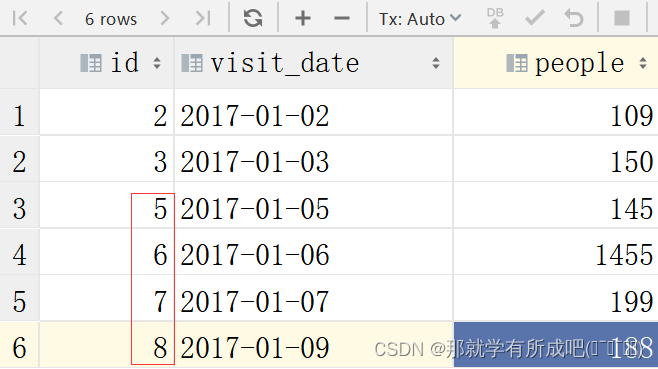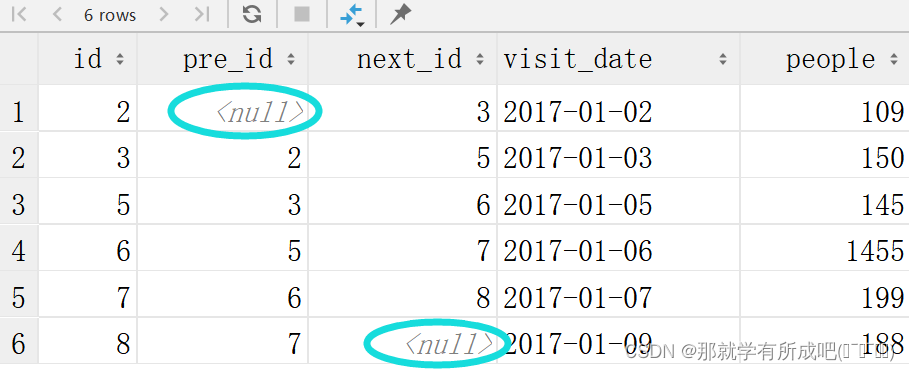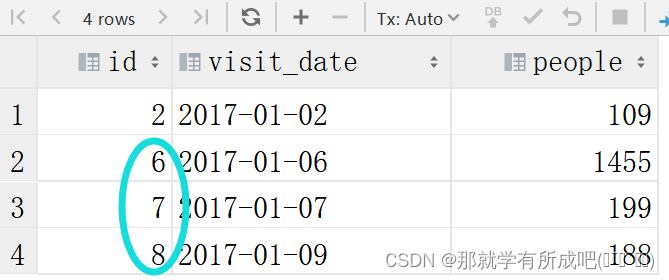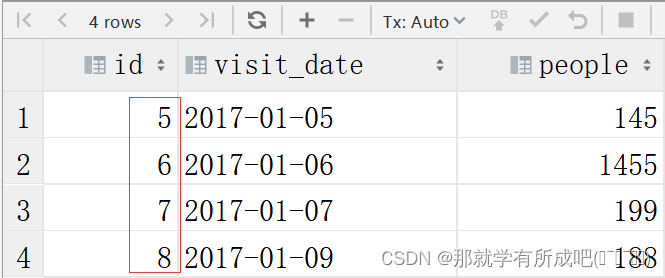SQL 技巧笔记
前言:我发现大数据招聘岗位上的应聘流程都是需要先进行笔试,其中占比很大的部分是SQL题目,经过一段时间的学习之后,今天开了一个力扣年会员,我觉得我很有必要去多练习笔试题目,这些题目是有技巧性的,很贴近生活!
Tips:我很享受独自做出题目的感觉,也很喜欢和大家分享自己的思路!我会继续努力,遇到有趣的题目,独特的思路会和大家多多交流!
文章目录
- SQL 技巧笔记
- 一、连续 3 人的连号问题
- 1. 题目来源
- 2. 题目描述
- 3. 题目理解
- 4. 思路顺序
- (1) 筛选每行的人数大于或等于 `100`
- (2) 找出 id,前一个 id,后一个 id
- (3) 找出三个id之间的关系
- (4) 找出五个id之间的关系
- 5. 提交答案
一、连续 3 人的连号问题
1. 题目来源
- LeetCode 601.体育馆的人流量
- 困难型题目
- 网易公司的笔试题
2. 题目描述
表:Stadium
+---------------+---------+
| Column Name | Type |
+---------------+---------+
| id | int |
| visit_date | date |
| people | int |
+---------------+---------+
visit_date 是该表中具有唯一值的列。
每日人流量信息被记录在这三列信息中:序号 (id)、日期 (visit_date)、 人流量 (people)
每天只有一行记录,日期随着 id 的增加而增加
编写解决方案找出每行的人数大于或等于 100 且 id 连续的三行或更多行记录。
返回按 visit_date 升序排列 的结果表。
查询结果格式如下所示。
示例 1:
输入:
Stadium 表:
+------+------------+-----------+
| id | visit_date | people |
+------+------------+-----------+
| 1 | 2017-01-01 | 10 |
| 2 | 2017-01-02 | 109 |
| 3 | 2017-01-03 | 150 |
| 4 | 2017-01-04 | 99 |
| 5 | 2017-01-05 | 145 |
| 6 | 2017-01-06 | 1455 |
| 7 | 2017-01-07 | 199 |
| 8 | 2017-01-09 | 188 |
+------+------------+-----------+
输出:
+------+------------+-----------+
| id | visit_date | people |
+------+------------+-----------+
| 5 | 2017-01-05 | 145 |
| 6 | 2017-01-06 | 1455 |
| 7 | 2017-01-07 | 199 |
| 8 | 2017-01-09 | 188 |
+------+------------+-----------+
解释:
id 为 5、6、7、8 的四行 id 连续,并且每行都有 >= 100 的人数记录。
请注意,即使第 7 行和第 8 行的 visit_date 不是连续的,输出也应当包含第 8 行,因为我们只需要考虑 id 连续的记录。
不输出 id 为 2 和 3 的行,因为至少需要三条 id 连续的记录。
数据源:
Create table If Not Exists Stadium (id int, visit_date DATE NULL, people int);
Truncate table Stadium;
insert into Stadium (id, visit_date, people) values ('1', '2017-01-01', '10');
insert into Stadium (id, visit_date, people) values ('2', '2017-01-02', '109');
insert into Stadium (id, visit_date, people) values ('3', '2017-01-03', '150');
insert into Stadium (id, visit_date, people) values ('4', '2017-01-04', '99');
insert into Stadium (id, visit_date, people) values ('5', '2017-01-05', '145');
insert into Stadium (id, visit_date, people) values ('6', '2017-01-06', '1455');
insert into Stadium (id, visit_date, people) values ('7', '2017-01-07', '199');
insert into Stadium (id, visit_date, people) values ('8', '2017-01-09', '188');
3. 题目理解
-
需求一:编写解决方案找出每行的人数大于或等于
100 -
需求二:且
id连续的三行或更多行记录。 -
需求三:返回按
visit_date升序排列 的结果表。
4. 思路顺序
(1) 筛选每行的人数大于或等于 100
代码:
SELECT*
FROM Stadium WHERE people >=100
效果:发现 id 为 5, 6, 7, 8 满足至少连 3 号

(2) 找出 id,前一个 id,后一个 id
代码:
SELECTid,LAG(id,1) OVER(ORDER BY id) as pre_id, # 前一个idLEAD(id,1) OVER(ORDER BY id) as next_id, # 后一个idvisit_date,peopleFROM Stadium WHERE people >=100
效果:发现最前面的id 的前一个id为null,最后一个id的后一个id为null

(3) 找出三个id之间的关系
代码:
with t1 as(SELECTid,LAG(id,1) OVER(ORDER BY id) as pre_id, # 前一个idLEAD(id,1) OVER(ORDER BY id) as next_id, # 后一个idvisit_date,peopleFROM Stadium WHERE people >=100
)
select id,visit_date,people from t1
where
(id = pre_id + 1 and id = next_id - 1) OR # 当前 id 是连续序列的中间部分
(next_id = id + 1 and pre_id is null ) OR # 当前 id 是连续序列的最开始部分
(pre_id = id - 1 and next_id is null) # 当前 id 是连续序列的最结束部分
order by id;
效果:发现原本需要的 5 居然不见了,明显找三者关系条件远远不够

(4) 找出五个id之间的关系
代码:
with t1 as(SELECTid,LAG(id,1) OVER(ORDER BY id) as pre_id, # 前一个idLAG(id,2) OVER (ORDER BY id) as pre_2_id, # 前两个idLEAD(id,1) OVER(ORDER BY id) as next_id, # 后一个idLEAD(id,2) OVER(ORDER BY id) as next_2_id, # 后两个idvisit_date,peopleFROM Stadium WHERE people >=100
)
select id,visit_date,people from t1
where
(id = pre_id + 1 and id = next_id - 1) OR # 当前 id 是连续序列的中间部分
(pre_id is null and next_id = id + 1 and next_2_id = id + 2 ) OR # 当前 id 是连续序列的最开始部分
(next_id = id + 1 and next_2_id = id + 2 ) OR # 当前 id 是连续序列的最开始部分
(id = pre_id + 1 and next_id is NULL and pre_2_id = id - 2) OR # 当前 id 是连续序列的最结束部分
(pre_id = id - 1 and pre_2_id = id - 2) # 当前 id 是连续序列的最结束部分
order by id;
效果:答案正确,3 个id的联系需要考虑极端情况,所以一共需要 5个 条件!

5. 提交答案
效果展示:经过20分钟思考,解题结果提交通过!

对比官方:官方的答案很简略,不过我觉得自己想出来的思路很有趣哦!
# 官方答案select distinct t1.*
from stadium t1, stadium t2, stadium t3
where t1.people >= 100 and t2.people >= 100 and t3.people >= 100
and
((t1.id - t2.id = 1 and t1.id - t3.id = 2 and t2.id - t3.id =1) -- t1, t2, t3or(t2.id - t1.id = 1 and t2.id - t3.id = 2 and t1.id - t3.id =1) -- t2, t1, t3or(t3.id - t2.id = 1 and t2.id - t1.id =1 and t3.id - t1.id = 2) -- t3, t2, t1
)
order by t1.id;






JavaPythonC++JS实现))
)







![[element]element-ui框架下载](http://pic.xiahunao.cn/[element]element-ui框架下载)

。Javaee项目,springboot项目。)

